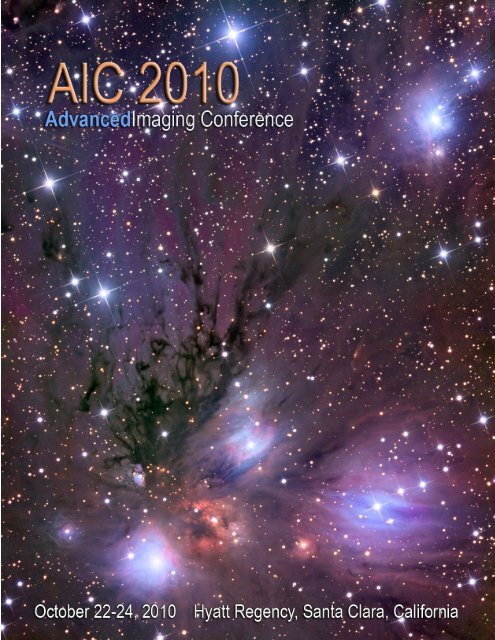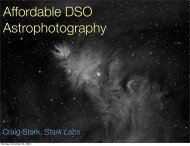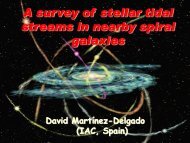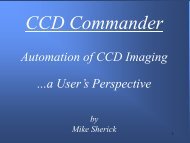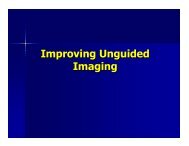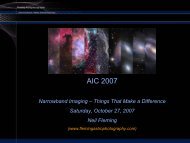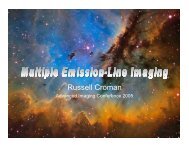Advanced Imaging Conference October 22-24, 2010 Santa Clara ...
Advanced Imaging Conference October 22-24, 2010 Santa Clara ...
Advanced Imaging Conference October 22-24, 2010 Santa Clara ...
- No tags were found...
You also want an ePaper? Increase the reach of your titles
YUMPU automatically turns print PDFs into web optimized ePapers that Google loves.
<strong>Advanced</strong> <strong>Imaging</strong> <strong>Conference</strong> <strong>October</strong> <strong>22</strong>-<strong>24</strong>, <strong>2010</strong> <strong>Santa</strong> <strong>Clara</strong>, California http://www.aicccd.com Page 1
Board of DirectorsKen CrawfordPresidentKen Crawford is one of the foundingmembers of the <strong>Advanced</strong> <strong>Imaging</strong><strong>Conference</strong> and is the current president.Ken lives in Camino, California,with his lovely wife, Lisa, and isan avid astro-imager. He loves toshare and talk image processing methods; and enjoys allthe friends he has made through this wonderful hobby.You can see his images and tutorials atwww.imagingdeepsky.com.Frank S Barnes,IIITreasurerFrank Barnes earned his BS in ElectricalEngineering in 1977. Afterworking 30 years in the communicationsindustry, he retired from ComporiumCommunications where heheld the position of Executive VPBusiness Development. Frank started imaging in 2000,and currently uses various SBIG cameras with his 16-inchRCOS, FSQ-106N, Takahashi E-180 and AP180EDT.His other hobbies include fishing, pyrotechnics and RVing.www.skyimager.comAl DegutisPublisherWhen Al Degutis is not addressingtechnology issues as the IT Managerfor a software development company,he wears the hat of Editor-in-Chief of AstroPhoto Insight Magazine,a digital publication devoted tothe pursuit of astrophotography. AstroPhoto Insight isdedicated to exploring and sharing the latest innovationsand techniques in the field of cutting-edge amateur astrophotography.www.astrophotoinsight.comR Jay GabanyWebmaster & MarketingJay GaBany has a thirty-year careerbackground in the travel industry managinglarge travel agencies handlingtravel expense management for corporationsand, since 1997, designingon-line reservation systems for businessand vacation travelers. The adult expression of hisboyhood space age fascination is evident in his writing,deep space imagery and research collaboration into galacticevolution. Jay's observatory is in the south-centralmountains of New Mexico. www.cosmotography.comKeith AllredSecretary & Legal CounselKeith Allred has been an active amateurastronomer since 1994. He justfinished construction of a remote observatoryin the Sacramento Mountains(next door to New MexicoSkies). He is a partner with DavisWright Tremaine, a law firm with tenoffices in the U.S. and China. He serves as a board memberand secretary of AIC, and is its legal counsel.www.orionobservatory.comBob FeraRegistrarBob, an Information Technology Managerfor a small computer services company inLos Angeles, spent ten years photographinggalaxies and nebulae with a35mm SLR camera and color negativefilm until he entered the digital age in2003. Many of his images, both film and digital, appear regularlyin magazines as well as in other print and electronicmedia. Bob currently takes his images from his home observatoryunder the dark skies of Foresthill, California.www.feraphotography.comWe extend a special thanks to The Van VleetFoundation for their many years of donations andsupport of The <strong>Advanced</strong> <strong>Imaging</strong> <strong>Conference</strong>.<strong>Advanced</strong> <strong>Imaging</strong> <strong>Conference</strong> <strong>October</strong> <strong>22</strong>-<strong>24</strong>, <strong>2010</strong> <strong>Santa</strong> <strong>Clara</strong>, California http://www.aicccd.com Page 2
AIC Founding SponsorsSponsorsEditorial SponsorsAdobe SystemsAstrodon <strong>Imaging</strong>Astro Haven EnterprisesAstro HutechATIK CamerasCanonCCDWareCelestronChronosMount, Inc.Finger Lakes InstrumentationFishcamp EngineeringExhibitorsHotechMount Lemmon SkyCenterNew Mexico Skies Astronomy EnclaveOceanside Photo & TelescopeOfficina StellareOptec Inc.Orion Telescopes & BinocularsQuantum Scientific <strong>Imaging</strong>Starlight Xpress Ltd.Woodland Hills Camera and Telescopes<strong>Advanced</strong> <strong>Imaging</strong> <strong>Conference</strong> <strong>October</strong> <strong>22</strong>-<strong>24</strong>, <strong>2010</strong> <strong>Santa</strong> <strong>Clara</strong>, California http://www.aicccd.com Page 3
Hyatt Regency <strong>Santa</strong> <strong>Clara</strong><strong>Advanced</strong> <strong>Imaging</strong> <strong>Conference</strong> <strong>October</strong> <strong>22</strong>-<strong>24</strong>, <strong>2010</strong> <strong>Santa</strong> <strong>Clara</strong>, California http://www.aicccd.com Page 4
<strong>2010</strong> Meeting AgendaFriday, <strong>October</strong> <strong>22</strong>SCHEDULE / SPEAKER EVENT LOCATION7:00AM- 8:30AM8:30AM- 10:00AM Workshop Track 1Friday Workshop RegistrationContinental Breakfast (included with registration fee)Neil Fleming The ABC's of Narrowband Image ProcessingStephen Bisque TheSkyX ProfessionalStevens CreekWinchesterDoug George Image Processing with MaximDL Napa 1 & 2Bob Denny Image Planning and Automation using ACP Napa 3Stan Moore Image Processing with CCDStack210:15AM- 11:45AM Workshop Track 2Zolt Levay & Lisa Frattare Processing Hubble Archive Images11:45AM- 1:30PM1:45PM- 3:15PM3:30PM- 5:00PMTony Hallas <strong>Advanced</strong> Image ProcessingLafayette/San Tomas/LawrenceStevens CreekBrad Moore Optimizing your Image Train Napa 1 & 2Don Goldman The ABC's of Image ProcessingJohn Smith &Steve WaltersImage Planning and Automation usingCCDNavigator and CCDAutopilotLunch (included with registration fee)Technology Showcase is openWorkshop Track 3Technology Showcase is openNeil Fleming The ABC's of Narrowband Image ProcessingTony Hallas <strong>Advanced</strong> Image ProcessingLafayette/San Tomas/LawrenceWinchesterNapa 3Stevens CreekDoug George Image Processing with MaximDL Napa 1 & 2Don Goldman The ABC's of Image ProcessingLafayette/San Tomas/LawrenceWinchesterBob Denny Image Planning and Automation using ACP Napa 3Workshop Track 4Technology Showcase is openStephen Bisque TheSkyX ProfessionalStevens CreekBrad Moore Optimizing your Image Train Napa 1 & 2Stan Moore Image Processing with CCDStack2John Smith &Steve WaltersImage Planning and Automation using CCDNavigatorand CCDAutopilotLafayette/San Tomas/LawrenceNapa 35:00PM- 6:00PM6:00PM- 7:30PM7:00PM- 8:00PM8:00PM- 10:00PMGeneral Session RegistrationTechnology Showcase is openDinner (included with registration fee)Technology Showcase is open<strong>Conference</strong> General Session Opener & Sponsor UpdatesTechnology Showcase is closed<strong>Advanced</strong> <strong>Imaging</strong> <strong>Conference</strong> <strong>October</strong> <strong>22</strong>-<strong>24</strong>, <strong>2010</strong> <strong>Santa</strong> <strong>Clara</strong>, California http://www.aicccd.com Page 5
Saturday, <strong>October</strong> 23SCHEDULE EVENT SPEAKER7:00AM- 8:45AMGeneral Session RegistrationFull Breakfast (included with registration fee)8:45AM- 9:45AM <strong>2010</strong> Hubble Award Lecture Russell Croman9:45AM- 10:30AM Wide Field Astrophotograpy Rogelio Bernal Andreo10:30AM- 11:00AM11:00AM- 11:45AM11:45AM- 1:00PMBreakTechnology Showcase is openFrom the Backyard to Space- Data Acquisition andProcessing Parallels between the Kepler Mission andAstrophotographyLunch (included with registration fee)Technology Showcase is openTodd Klaus1:00PM- 1:30PM Founding Sponsors Brad Erhorn, RCOSMichael Barber, SBIGStephen Bisque, Software Bisque1:30PM- 2:30PMAdding Depth to Hubble Images for Hubble 3D IMAX Zolt Levay & Lisa Frattare2:30PM- 3:00PM3:00PM- 4:00PMBreakTechnology Showcase is openThe Frequency Domain and Future of CCD Technologyfor AstrophotographyKevin Nelson4:00PM- 5:00PM AIC Spotlight Presentations Michael JonerBob FeraJohn Smith5:00PM- 6:00PM6:00PM- 7:30PM7:30PM- 9:00PMSunday, <strong>October</strong> <strong>24</strong>7:00AM- 8:20AMTechnology Showcase is openDinner (included with registration fee)Technology Showcase is openFull Breakfast (included with registration fee)Technology Showcase is open but closes at the end of this event.8:30AM- 9:15AM Obtaining Correct Star Color with G2V Al Kelly9:15AM- 10:30AM High Resolution Image Processing Martin Pugh10:30AM- 11:00AMDoor prize drawing (you must be present to win)<strong>Conference</strong> adjourns at conclusion of this event.<strong>Advanced</strong> <strong>Imaging</strong> <strong>Conference</strong> <strong>October</strong> <strong>22</strong>-<strong>24</strong>, <strong>2010</strong> <strong>Santa</strong> <strong>Clara</strong>, California http://www.aicccd.com Page 6
<strong>2010</strong> Hubble AwardRussell CromanRuss lives in suburban Austin, Texas with his wife and threedaughters. Professionally, Russ is a chip design manager for alocal Austin company named Silicon Laboratories. His successas one of the world's leading astrophotographers can be tracedto experiences from his past and the requirements of his career.For example, while Russ was earning his Master's at WashingtonState University, he volunteered to take news and sportsphotographs for the student newspaper. During this period, helearned about image composition and other important conceptsthat work in combination to produce better photographs.The field of chip design requires a thorough understanding ofphysics and electronics. Modern IC's often have well over ahundred thousand parts and require constant attention to detailduring their development. Leveraging the skills used to de-bug chip layout issues and keep mission criticalprojects on schedule also helped Russ diagnose and solve unexpected situations during a night's photographicsession or when an image was being processed.Russ was one of the original AIC Board members, serving from 2004 through 2006 as its Registrar. Much ofAIC’s continuing success rests upon the hard work he selflessly contributed. He was also one of the first torecognize the value and overcome the challenges of operating a remote observatory located far from city lightpollution. His Dimension Point Observatory, situated high in the south central Sacramento Mountains of NewMexico, is equipped with a half meter telescope. It was oneof the first private fully-remote installations in that area andit helped lead a small stampede that has made Mayhill,New Mexico, one of the world's leading astrophotographycapitals.Russ also helped popularize the use of mapped color imagery.His techniques are presented in Ron Wodaski's 'TheNewAstro Zone System for Astro <strong>Imaging</strong>', which Russ coauthored.Pursuing his career as a professional integrated circuit designer,Russ nonetheless exhibits the aesthetic heart of agifted artist- just a brief glance at Russ' images can evokestrong reactions from even the most jaded viewer. Manyconsider Russ to be the finest astrophotographer on theplanet!The Hubble Award is presented to those individualswho have demonstrated significantand sustained contributions to the astrophotographycommunity over a period ofyears. Production of fine images is only onecriteria but certainly not the most importantfactor that is considered. Popularizationthrough public outreach, technical innovation,scientific contributions and selfless directsupport to other imagers also represent keycriteria that justify designation as a HubbleAward recipient.Final selection is made by a unanimous voteof the AIC Board of Directors.Cover Photo: NGC 2170 by Russell Croman - APOD February 28, 2007This LRGB image of NGC 2170 was taken by Russell Croman with a SBIG STL-11000XM using a 20" f/8RCOS Ritchey-Chrétien Cassegrain w/ RCOS Field Corrector. Exposure times, in minutes, were LRGB =L=360, R=<strong>24</strong>0, G=120, B=<strong>24</strong>0 using SBIG Standard LRGB filters.<strong>Advanced</strong> <strong>Imaging</strong> <strong>Conference</strong> <strong>October</strong> <strong>22</strong>-<strong>24</strong>, <strong>2010</strong> <strong>Santa</strong> <strong>Clara</strong>, California http://www.aicccd.com Page 7
Rogelio Bernal AndreoAstrophotographerblog.deepskycolors.comWide field and Multi-Scale ProcessingThis presentation will discuss: framing and capturing original skyscapes, color techniques that include gradual saturation, chromaticnoise reduction and color sharpening, several unique processing techniques and multi-scale processingwhich involves star masking, making faint detailsvisible and enhancing details in bright structures.Rogelio was born in Spain but has been living in the United States for over 20 years.He commenced producing astronomical photographs only two years ago. However, during the last 12 months,his work has been featured on APOD 8 times, published in several astronomy publications, used in planetariums,astronomy exhibits at museums, and appeared in the IMAX/Warner Bros. motion picture production Hubble3D (http://www.imax.com/hubble).Rather than simply trying to obtain the best image, he constantly challenges himself to ensure the final pictureconnects with the viewer by focusing on composition and experimenting with new processing techniques. Interestingly,Rogelio does not have a permanent observatory so his imaging requires extensive traveling to darksites.From the Trunk to the Bubble / APOD <strong>2010</strong> September 9 / Rogelio Bernal Andreo3x4 mosaic (12 frames) captured during a visit to Spain the summer of <strong>2010</strong>, over 4 nights.FSQ 106 EDX w/Reducer; SBIG STL11k; StarShoot Autoguider; Takahashi EM-400<strong>Advanced</strong> <strong>Imaging</strong> <strong>Conference</strong> <strong>October</strong> <strong>22</strong>-<strong>24</strong>, <strong>2010</strong> <strong>Santa</strong> <strong>Clara</strong>, California http://www.aicccd.com Page 8
Steve BisqueFounder & President, Software Bisquewww.bisque.comUsing TheSkyX Professional EditionThis presentation will demonstrate the latest version of theSky-TheSkyX Professional Edition.Retooled from the ground up, Software Bisque has added a hostof exciting features the world's favorite desktop/ telescope controlastronomy software.Virtually every feature has been redesigned to emphasize ease ofuse: Mac or Window operating system support Screen refreshes as fast as your graphics hardware will allow. Improved telescope control- features native telescope driverswith extensive driver support. Full T-Point integration.Stephen Bisque is president and founder of Software Bisque. Stephen is currently one of the leadprogrammers working on TheSkyX, and is closely involved in the design of robotic telescopemounts. For over 25 years he has enjoyed marrying the latest computer and telescope technologieswith TheSky family of software products.<strong>Advanced</strong> <strong>Imaging</strong> <strong>Conference</strong> <strong>October</strong> <strong>22</strong>-<strong>24</strong>, <strong>2010</strong> <strong>Santa</strong> <strong>Clara</strong>, California http://www.aicccd.com Page 9
<strong>Advanced</strong> <strong>Imaging</strong> <strong>Conference</strong> <strong>October</strong> <strong>22</strong>-<strong>24</strong>, <strong>2010</strong> <strong>Santa</strong> <strong>Clara</strong>, California http://www.aicccd.com Page 10
<strong>Advanced</strong> <strong>Imaging</strong> <strong>Conference</strong> <strong>October</strong> <strong>22</strong>-<strong>24</strong>, <strong>2010</strong> <strong>Santa</strong> <strong>Clara</strong>, California http://www.aicccd.com Page 11
Bob DennyFounder- DC3 DreamsPrincipal Developer- ACP Observatory Controlwww.dc3.comUsing ACP to Plan and Acquire <strong>Imaging</strong> DataBoth the quantity and the quality of raw image data are the foundationsof successful art astronomy. Automated image acquisition is essentialto getting the most out of your observatory. When that's still notenough, you can move your observatory to a remote location whichprovides both better image quality and more usable imaging time. Remoteimaging clearly requires automation.First introduced in 1999, adding web-based automation in 2002, ACPObservatory Control Software has evolved towards ease of use as wellas flexibility. This presentation will begin by discussing the reasons forcombining automation and web control, who is using ACP, and a bit about how it works and how to use it. After this, anew approach to scheduling image acquisition will be covered. This will be an informal talk, with plenty of question andanswer time throughout.Bob Denny has been involved full time for over ten years developing new- generation astronomy software, focusing onastronomy automation as well as remote observatory operation through a web browser (for which automation is a prerequisite).He is also the originator and still a primary evangelist for the ASCOM Initiative, which has freed astronomysoftware developers from having to write low-levelcontrol code for the myriad of computer-controllableastronomy instruments and devices that have appearedin recent years.Bob is quick to say that he is not an astronomer; he isan engineer and software designer. However he has athorough knowledge of the needs of both science andart astronomers and their technologies. Software hasbeen his real love for most of his life, having written hisfirst program in 1963. Since then he has worked on awide range of machines using a wide variety of languages.In addition, he is an expert with the latest webtechnologies and browser-based scripting in Javascript.In the past, Bob has worked as a broadcast televisionengineer (while attending University), ten years in aerospaceengineering and flight test, consulting for EMMand Xerox on special projects, then founding and operatinga medium sized software business as CEO forfourteen years. Following that, he developed the firstweb server on Windows, made Visual Basic a webback-end programming language, and created the firstJava based web server back-end.Bob holds a BSEE from the University of Arizona, anFAA pilot's license with multi-engine and instrumentratings, and numerous certifications related to his volunteerlaw enforcement work with the Maricopa County(AZ) Sheriff's Office. Bob is enthusiastic about almosteverything!<strong>Advanced</strong> <strong>Imaging</strong> <strong>Conference</strong> <strong>October</strong> <strong>22</strong>-<strong>24</strong>, <strong>2010</strong> <strong>Santa</strong> <strong>Clara</strong>, California http://www.aicccd.com Page 12
Neil FlemingAstrophotographerwww.flemingastrophotography.comThe ABC's of Narrow Band <strong>Imaging</strong>- The Tough Parts andWhat to do About ThemThis "how-to" talk is designed for the imager who is familar with white lightimaging through LRGB filters but wants to try some narrowband work. Thetheme is how to deal with the challenges that are inherent to narrowbandimaging and processing:What's different about narrowband imaging versusRGB/LRGB imaging?Approaches to autoguidingHow to handle noisy dataColor adjustments and how to handle the overwhelming green (Ha) dataAdding in natural color RGB stars to your narrowband imagesNeil Fleming specializes in the capture of high-quality images from very light polluted locations such as those in theBoston area. As such, the majority of his work is in the area of narrowband imaging, using Ha, OIII, and SII filters.His images have been published in both Sky & Telescope and Astronomy magazines, and featured on the popularAstronomy Picture of the Day (APOD) web site. Additionally, his imagery was included in Timothy Ferris PBS documentarySeeing in the Dark.His past speakingengagementshave includedsuchpopular conferencesas the<strong>Advanced</strong> <strong>Imaging</strong><strong>Conference</strong>,the MidwestAstro-<strong>Imaging</strong><strong>Conference</strong>,and the North-East Astro-<strong>Imaging</strong> <strong>Conference</strong>each anannual eventoriented towardsastrophotographerswanting to learnmore about thetechniques usedfor advancedimage processing.IC 5146: The Cocoon Nebula / APOD <strong>2010</strong> March 5 / Neil Fleming, David Plesko14.5" RCOS, SBIG STL11000M, Astrodon CRGB filters<strong>Advanced</strong> <strong>Imaging</strong> <strong>Conference</strong> <strong>October</strong> <strong>22</strong>-<strong>24</strong>, <strong>2010</strong> <strong>Santa</strong> <strong>Clara</strong>, California http://www.aicccd.com Page 13
Lisa FrattareImage ProcessorHubble Heritage Teamhttp://heritage.stsci.eduWorkshop: Mining Images from the Hubble Legacy ArchiveA convergence of technologies now makes it more convenient to producecolor photographs from Hubble Space Telescope data. TheHubble Legacy Archive (HLA) provides a navigation system into theextensive archive of Hubble data and the Adobe Photoshop plugin,FITS Liberator, provides the tools to transform files from the archiveinto color images. We will describe relevant features of Hubble's camerasand the resulting data that may be suitable for constructing colorcomposite images, and take a tour of the Hubble Data Archive andthe HLA interface to highlight the most useful capabilities for imageprocessors. We will demonstrate FITS Liberator, using Photoshop toconstruct Hubble photos.General <strong>Conference</strong> Session: Visualizing Hubble Images in the Third DimensionThe IMAX film Hubble 3D provides a front-row seat to the dramatic final Space Shuttle mission to service the HubbleSpace Telescope. Exciting, in-your-face, as-it-happened footage from the mission is complemented by unprecedentedviews of astronomical landscapes in the spectacular format of the large IMAX screen in full stereo. Thefilm helps us appreciate not only what it takes to keep Hubble at peak performance but also why we spend the effortto do so: unparalleled science observations and spectacular views of the universe. Of course, Hubble does notimage in stereo, but through a few specialized techniques we can visualize a 3D landscape, much of it informed bydetailed analysis of the Hubble data. Get an inside look at how these scenes were produced and rendered for theIMAX screen. We will discuss the different techniques we used to permit our audience to fly through the OrionNebula, see Saturn suspended in the middle of the movie theater, be inside a globular cluster, and much more.Lisa Frattare is a native of Rochester, NY. Shereceived her undergraduate degrees in ClinicalPsychology (cum laude) at SUNY Oswego andPhysics/Astronomy at Arizona State University.She earned an M.A. in Astronomy from WesleyanUniversity in 1996. She has been at STScI(research institute for the Hubble Space Telescope)since 1996, first as a data analyst and lateras an image processor for the Hubble HeritageTeam and the Office of Public Outreach NewsTeam. She has been with the Heritage Projectsince a year before its public debut in 1998. Overthe course of her tenure, the Heritage Project hasproduced nearly 150 image releases.Lisa loves telescope observing, whether with Hubbleor ground-based telescopes. In addition to logging in approximately 300 hours at the Van Vleck Observatory<strong>24</strong>-inch Perkin Reflector at Wesleyan University in CT, she has had the pleasure of using the Lowell Observatory42-inch telescope in Flagstaff and the Kitt Peak 42-inch, 0.9m, and 0.6m Burrell Schmidt telescopes in Arizona;the Cerro Tololo Interamerican Observatory 4m and 0.9 m telescopes in Chile; and the KECK II NIRSPEC inWaimea, HI. Lisa has also observed remotely with the International Ultraviolet Explorer (IUE).The Hubble Space Telescope has produced fantastic images for scientific discovery and public outreach. Lisa hasfacilitated observations for nearly 70 Hubble targets. She shares common goals with her STScI and Hubble Heritagefamilies in a desire to make each new observation a rewarding experience for the public. Her imaging workfrom Hubble has been published in a myriad of books and magazines and has been used in the <strong>2010</strong> IMAX 3Dmovie, Hubble 3D (www.imax.com/hubble).<strong>Advanced</strong> <strong>Imaging</strong> <strong>Conference</strong> <strong>October</strong> <strong>22</strong>-<strong>24</strong>, <strong>2010</strong> <strong>Santa</strong> <strong>Clara</strong>, California http://www.aicccd.com Page 14
Doug GeorgePresident, Diffraction Limitedwww.cyanogen.comUsing Maxim DLOne of the most popular software applications used by astrophotographersin the production of images is MaxIm DL. Doug's workshopwill focus on many of the most frequently used Maxim tools including:Screen stretch, bit depth, file formatsCalibration including an explanation of calibration groupsStacking including selection, quality check, alignment, stack, colorcombine DDP, curves, color enhancementDoug George is a professional engineer with <strong>24</strong> years experience in the design of electronics, embedded systems, andapplication software. He is President of Diffraction Limited, which produces imaging products including MaxIm DL imagingsoftware, MaxPoint telescope pointing software, the MaxDome observatory dome automation system, and the BoltwoodCloud Sensor.Doug's observing interests include astrophotography, occultations, and patrol programs. He co-discovered CometSkorichenko-George visually, and has co-discovered 12 supernovae as part of the Pucket Supernova Search program.Doug is a Life Member of the Royal Astronomical Society of Canada, Past President of both the RASC nationally and theRASC Ottawa Centre. and a member of the Professional Engineers. His honors and awards include The 2001 EngineeringMedal for Engineering Excellence from the Professional Engineers Ontario and he has been awarded the RASC KenChilton Prize on three separate occasions.Total Solar Eclipse 2006 / Doug GeorgeImage of the diamond ring; 0.003 second exposure using Canon 20Da, Takahashi FSQ-106, Losmandy GM8 mount.Image auto-sequenced and processed using MaxIm DL to reveal details in the inner corona (custom radial gradientmask plug-in, Curves).<strong>Advanced</strong> <strong>Imaging</strong> <strong>Conference</strong> <strong>October</strong> <strong>22</strong>-<strong>24</strong>, <strong>2010</strong> <strong>Santa</strong> <strong>Clara</strong>, California http://www.aicccd.com Page 15
Don GoldmanAstrophotographerPresident, Astrodon Filterswww.astrodon.comProcessing Workflow and Image Enhancement for Vibrant ImagesThis workshop will provide an overview of basic processing from calibration,registration, data rejection, and combining. Different imagesgenerally require different fixes and enhancements. The session willcover many of these using Photoshop, such as gradient removal, starelongation, color saturation, noise removal, contrast enhancement, starsize reduction and localized sharpening.Don is the founder and president of Astrodon Filters and the founderand past president of Optical-Solutions, a designer- manufacturer ofsold fiber-optic chemical analyzers for on-line, real-time chemical monitoringof manufacturing processes. He holds both a B.S. in geologyand an MBA from the University of Washington and a Ph.D. in analytical spectroscopy from CalTech.Don has been awarded 14 U.S. patents (including several that are classified), has published over 25 peer-reviewedpapers regarding mineralogy and glass research, is a regular speaker at popular national astronomy conferences,has published two articles in Sky and Telescope, received the 2009 Clyde Tombaugh award from Riverside TelescopeMakers <strong>Conference</strong> and is a member of AAVSO and SAS.Northern and Southern Owls / APOD <strong>2010</strong> May 6 / Don GoldmanOn the left is M97 in the constellation Ursa Major, also known in the northern hemisphere as the Owl Nebula. On theright is its visual counterpart, the southern Owl Nebula in the constellation Hydra, cataloged as PLN 283+25.1RC Optical 16" f/8.9 Ritchey-Chretien; Apogee U16M; Software Bisque Paramount MEExposure Time: 10.3 hours Total of 3nm H-a, NII, OIII<strong>Advanced</strong> <strong>Imaging</strong> <strong>Conference</strong> <strong>October</strong> <strong>22</strong>-<strong>24</strong>, <strong>2010</strong> <strong>Santa</strong> <strong>Clara</strong>, California http://www.aicccd.com Page 16
<strong>Advanced</strong> <strong>Imaging</strong> <strong>Conference</strong> <strong>October</strong> <strong>22</strong>-<strong>24</strong>, <strong>2010</strong> <strong>Santa</strong> <strong>Clara</strong>, California http://www.aicccd.com Page 17
Tony HallasRenowned Astrophotographer2009 Hubble Award Recipientwww.astrophoto.com<strong>Advanced</strong> Image Processing TechniquesTony's astrophotographic career can be summarized as a series offirsts. For example, starting out over 25 years ago, he was one ofthe first to produce film-emulsion images using an autoguider. Tonywas also one of the first to champion the use of stacked astronomicalimages as a method that improved the final picture's signal tonoise.Particularly during the early years of digital astrophotography, Tony'spictures were the reference to which digital imagers comparedtheir images. Finally, to many in the community, Tony's images remainthe first among equals in their aesthetic quality, composition and color! Tony's pictures have been publishedin countless magazines, television productions and books. He is a highly regarded speaker and the recipientof numerous, prestigious awards including the 2009 AIC Hubble Trophy.Pelican NebulaClose-upTony HallasAPOD<strong>2010</strong> August 19Plane Wave CDK 17f/6.8Apogee 16803Astrodon Gen II filters;A/P 1200 GTOL (Ha)(OIII) R (Ha) G(OIII) B (OIII)L = 900 x 9 eachRGB = 900 x 7, 2 x 2Ha = 2700 x 10O III 2700 x 6 1<strong>Advanced</strong> <strong>Imaging</strong> <strong>Conference</strong> <strong>October</strong> <strong>22</strong>-<strong>24</strong>, <strong>2010</strong> <strong>Santa</strong> <strong>Clara</strong>, California http://www.aicccd.com Page 18
<strong>Advanced</strong> <strong>Imaging</strong> <strong>Conference</strong> <strong>October</strong> <strong>22</strong>-<strong>24</strong>, <strong>2010</strong> <strong>Santa</strong> <strong>Clara</strong>, California http://www.aicccd.com Page 19
Al KellyAstrophotographerwww.kellysky.netObtaining G2V Star ColorAl's presentation will discuss the necessity of obtaining accurate whitebalance, the significance of G2V star color in the reproduction of accuratehues, correcting for extinction and the importance of equalized non-linear stretching.Al is one of the most highly experienced astrophotographers in thecommunity, producing astronomical images since the early 1960's usingfilm emulsion technology.He began working with CCD's in the late 1980's with a Photometrics Star 1 camera. During the opening years of thenext decade, Al turned to the SBIG ST4 and ST6 cameras.He built a Cookbook <strong>24</strong>5 camera in 1993 then pressed it into service until 2001 when he acquired a StarlightXpress SXMX916, which he uses to this day.Abell <strong>22</strong>18: A Galaxy Cluster Lens / APOD <strong>2010</strong> June 20 / Andrew Fruchter (STScI) et al., WFPC2, HST, NASADigitally reprocessed: Al Kelly<strong>Advanced</strong> <strong>Imaging</strong> <strong>Conference</strong> <strong>October</strong> <strong>22</strong>-<strong>24</strong>, <strong>2010</strong> <strong>Santa</strong> <strong>Clara</strong>, California http://www.aicccd.com Page 20
Todd KlausLead EngineerKepler Science Operations Center, NASA AmesFrom the Backyard to Space -Parallels Between the Kepler Missionand the Backyard AstrophotographerRecently launched in March 2009, the Kepler Space Telescope is on amission to search for Earth-size exo-planets in the habitable zone ofdistant stars using the photometric transit method. Kepler contains thelargest camera to ever fly in space, consisting of 42 CCDs for a total ofnearly 95 mega-pixels!Despite the complexity of Kepler, there are many similarities between howKepler collects and processes data and the work flow of the backyard astrophotographer.Todd will discuss how data are collected on board the spacecraft and how thesedata are processed on the ground, including pixel-level calibration and photometryand how these processes compare to ground-based imaging. He willalso touch on the great science and unprecedented precision coming from theKepler Mission.Todd will discuss how data are collected on board the spacecraft and how thesedata are processed on the ground, including pixel-level calibration and photometryand how these processes compare to ground-based imaging. He willalso touch on the great science and unprecedented precision coming from theKepler Mission.Todd Klaus is the lead engineer for the Kepler Science Operations Center atNASA Ames Research Center. Todd has been with the Kepler mission since2005, where he designed the pipeline infrastructure software used for theground processing of the Kepler data. When his two small children allow it, healso likes to spend time in his backyard observatory where he dabbles in photometryusing an 12.5" RCOS and an SBIG ST-10XME.Kepler Spacecraft and Photometer<strong>Advanced</strong> <strong>Imaging</strong> <strong>Conference</strong> <strong>October</strong> <strong>22</strong>-<strong>24</strong>, <strong>2010</strong> <strong>Santa</strong> <strong>Clara</strong>, California http://www.aicccd.com Page 21
<strong>Advanced</strong> <strong>Imaging</strong> <strong>Conference</strong> <strong>October</strong> <strong>22</strong>-<strong>24</strong>, <strong>2010</strong> <strong>Santa</strong> <strong>Clara</strong>, California http://www.aicccd.com Page <strong>22</strong>
Zolt Levay<strong>Imaging</strong> Group LeadSpace Telescope Science InstituteWorkshop: Mining Images from the Hubble Legacy ArchiveA convergence of technologies now makes it more convenient to producecolor photographs from Hubble Space Telescope data. The Hubble LegacyArchive (HLA) provides a navigation system into the extensive archive ofHubble data and the Adobe Photoshop plugin, FITS Liberator, provides thetools to transform files from the archive into color images. We will describerelevant features of Hubble's cameras and the resulting data that may besuitable for constructing color composite images, and take a tour of theHubble Data Archive and the HLA interface to highlight the most useful capabilitiesfor image processors. We will demonstrate FITS Liberator, usingPhotoshop to construct Hubble photos.General <strong>Conference</strong> Session: Visualizing Hubble Images in the Third DimensionThe IMAX film Hubble 3D provides a front-row seat to the dramatic final Space Shuttle mission to service the HubbleSpace Telescope. Exciting, in-your-face, as-it-happened footage from the mission is complemented by unprecedentedviews of astronomical landscapes in the spectacular format of the large IMAX screen in full stereo. The film helps us appreciatenot only what it takes to keep Hubble at peak performance but also why we spend the effort to do so: unparalleledscience observations and spectacular views of the universe. Of course, Hubble does not image in stereo, butthrough a few specialized techniques we can visualize a 3D landscape, much of it informed by detailed analysis of theHubble data. Get an inside look at how these scenes were produced and rendered for the IMAX screen. We will discussthe different techniques we used to permit our audience to fly through the Orion Nebula, see Saturn suspended in themiddle of the movie theater, be inside a globular cluster, and much more.Zolt is <strong>Imaging</strong> Group Lead in the Office of Public Outreach at Space Telescope Science Institute in Baltimore, Maryland.Since 1993 he has primarily been responsible for producing publicly accessible images from Hubble Space Telescopedata to illustrate Hubble's science discoveries. He is a member of the Hubble Heritage Team, which strives toestablish a repository of the visually finestHubble imagery.Mr. Levay obtained a B.S. in astrophysicsin 1975 from Indiana University, Bloomington,Indiana and M.S. in astronomy in1978 from Case Western Reserve University,Cleveland, Ohio. He was employedby Computer Sciences Corp. as an analystand programmer with various spacescience missions at NASA s GoddardSpace Flight Center, Greenbelt, Maryland.He joined STScI in 1983 developing scienceanalysis software, and joined theOffice of Public Outreach in 1993 as animage-processingspecialist.Mr. Levay was awarded an Excellence inOutreach award from Goddard SpaceFlight Center in 1999, a Space TelescopeScience Institute Individual AchievementAward in November 1997, and the Associationof Universities for Research in Astronomy(AURA) 1997 Service Award.SN 1006 Supernova Remnant / APOD 2009 August 1 / Zolt LevayImage Credit: NASA, ESA, Zolt Levay (STScI)<strong>Advanced</strong> <strong>Imaging</strong> <strong>Conference</strong> <strong>October</strong> <strong>22</strong>-<strong>24</strong>, <strong>2010</strong> <strong>Santa</strong> <strong>Clara</strong>, California http://www.aicccd.com Page 23
Brad MooreManaging DirectorGlobal Rent-A-Scope.Optimizing Your <strong>Imaging</strong> TrainThis workshop will present key practical ideas on pushing your hardwareto obtain the best results. We'll look at how to optimize yourmount,telescope optics and CCD; learn practical solutions that overcomecommon challenges and review real life case studies.We'll also discuss: Optimizing PEC, improving tracking & polar alignment,improving your auto-guiding Troubleshooting common problems Tpoint & <strong>Advanced</strong> Modeling Understanding light reflections and how to deal with them Understanding your optics and collimation How optimize your observatory to minimize local seeing Matching the CCD to your telescope How to use software tools that measure and help you improve your system Understanding the basics of noise and how to minimize itBrad Moore is Managing Director of Global Rent-a-Scope, a world leading company in online telescope rentals. Sincebeing appointed to the position in 2006, Brad has brought a wealth of business experience and technical expertise tothe company. He has been instrumental in pioneering remote CCD imaging over the Internet, and has delivered28,500 imaging hours to over 3000 people, in 78 countries.As the owner of Southern-Astro Hosting, Brad is also responsible for establishing Australia largest telescope hostingfacility. Southern-Astro now has over <strong>22</strong> active systems under his direct management.Brad is an avid Astrophotographerand has producedaward-winning imagesof the southern hemisphere.His work has featured onNASA's APOD, books, magazinecovers and on the Hubbleweb site.Prior to joining Global Rent-a-Scope, Brad worked in theIT&T industry and was theState Manager for one of Australialeading business Telcoand Internet services providers.He has a strong backgroundin software, Internetcommunications, programmingand computing.Brad lives in Melbourne, Australiawith his wife and theirtwo young children. WhenBrad isn't working, he enjoysflying light aircraft and spendingtime with his young family.Eta and Keyhole in the Carina Nebula / APOD 16th March 2006 / Brad MooreRCOS 12.5" Ritchey-Chretien Cassegrain, Paramount ME, SBIG 2000XMExposure Total Time: 28 hours OIII: 6 hours Ha: 16 hours SII: 6 hour<strong>Advanced</strong> <strong>Imaging</strong> <strong>Conference</strong> <strong>October</strong> <strong>22</strong>-<strong>24</strong>, <strong>2010</strong> <strong>Santa</strong> <strong>Clara</strong>, California http://www.aicccd.com Page <strong>24</strong>
<strong>Advanced</strong> <strong>Imaging</strong> <strong>Conference</strong> <strong>October</strong> <strong>22</strong>-<strong>24</strong>, <strong>2010</strong> <strong>Santa</strong> <strong>Clara</strong>, California http://www.aicccd.com Page 26
Kevin NelsonFounderQuantum Scientific <strong>Imaging</strong>, Inc.www.qsimaging.comThe Frequency Domain and Future of CCD Technology for AstrophotographyFourier Transforms form the basis of digital signal processing, andprovide a unique and powerful method of analyzing 2D images.Fourier Transforms (FFTs) convert an image from the spatial domain,rows and columns in a digital picture, into its "FrequencyDomain," which represents the original image using a grid of sinewaves of varying frequency and amplitude. Understanding FourierTransforms will enhance your processing skills by giving you aricher understanding of what's going on "under the hood" and potentiallyopen up new tools and techniques you can use in processingyour astronomical images.Kevin will also discuss what can be expected in the future with digital image sensors for scientific cameras.Kevin Nelson is co-founder of Quantum Scientific <strong>Imaging</strong>, a manufacturer of cooled CCD cameras designedby and for astrophotographers. Kevin is an avid sailor and history buff whose interest in stargazing began withstudying the Age of Exploration and celestial navigation, and was reignited by the power of modern CCD cameras.Today, Kevin shares the joys and challenges of imaging the night sky from his backyard with his twosons.<strong>Advanced</strong> <strong>Imaging</strong> <strong>Conference</strong> <strong>October</strong> <strong>22</strong>-<strong>24</strong>, <strong>2010</strong> <strong>Santa</strong> <strong>Clara</strong>, California http://www.aicccd.com Page 27
Martin PughAstrophotographerwww.martinpughastrophotography.id.auHigh Resolution <strong>Imaging</strong>Martin will discuss key procedural aspects in data acquisition such asthe mount, scope and camera. This will be followed by a discussion onthe checks and balances necessary at every stage of image preparation.The talk will also present a brief overview of tools, guiding and dithering,image alignment and image combining.Martin will also offer some solutions to common irritations experiencedby all astrophotographers at one time or another such as image artifacts,preparation of the master luminance channel, blending narrowband data with LRGB exposures, fixing light pollutionnasties, correcting for red star halos, using the Photoshop minimum filter and correcting the artifacts it creates andgiving images impact without introducing or exaggerating noise.At 16 years of age, Martin Pugh left his home town of Dudley in the West Midlands (UK) to join the Royal Navy as aJunior Radio Operator. While he spent many nights staring into pitch-black mid-ocean skies using a pair of binoculars,his Naval career simply did not allow for any further pursuit in astronomy. For 20 years, he moved between ships andestablishments and in the late 90 s, together with the overwhelming appearance of Comet Hale Bopp in 1997, he becameincreasingly interested in the idea of observing and imaging. Then in 1999, he spent his first evening lookingthrough a dusty old 3-inch refractor recovered from his brother-in-law's loft, and instantly became fixated with the idea ofowning his own telescope, with the possible addition of a CCD camera.In Dec 1999, he was appointedto a NATO position in centralBelgium where the consistentlypoor air quality frustrated him ashe attempted to take imageswith a modest 8-inch telescopeand small digital camera. In2002, he moved to light pollutedLisbon, upgraded his equipmentand concentrated on planetarylunarimaging for the next twoyears. A navel career leads to asemi-nomadic lifestyle, so by2005 Martin found himself inAustralia under dark skies thatenabled him to begin producingdeep astrophotographic imagesfrom his backyard observatory.Martin has racked up a prodigiousnumber of noteworthyachievements including tenAPOD's, the 2008 David MalinAward, a three stamp collectorsset from the Australian Post Officeand the Royal GreenwichObservatory's Astronomy Photographerof the Year for 2009.NGC 1365: Majestic Island Universe / APOD <strong>2010</strong> August 20 / Martin Pugh12.5" Ritchey Chretien by RC Optical Systems, Paramount ME, SBIG STL11000M CCD Camera with AO-LExposure: Luminosity 12 hours, RGB 210:210:210<strong>Advanced</strong> <strong>Imaging</strong> <strong>Conference</strong> <strong>October</strong> <strong>22</strong>-<strong>24</strong>, <strong>2010</strong> <strong>Santa</strong> <strong>Clara</strong>, California http://www.aicccd.com Page 28
John SmithFounderCCDWare, Ltd.www.ccdware.comImage Planning and Automation using CCDNavigatorand CCDAutopilotThe sky is crystal clear and the Sun is setting. But when darkness falls,imagers everywhere are in a race against time! Because clear skies areprecious, we don't want to waste a second. And even on a mediocrenight, we still want rapid and precise acquisition. In this talk, John Smithand Steve Walters, authors of CCDAutopilot and CCDNavigator, willdiscuss and demonstrate your best weapons in the race against time,complete planning and automated execution.Born in Philadelphia,John Smith spent most ofhis career in the northeasternUS. With degreesin Physics and ElectricalEngineering, Johnworked in many aspectsof science and technology,eventually ending asa senior executive in ahigh technology company.Moving to a comfortableArizona retirement,his time soon becamefilled with hobbies likeastronomy, computersand photography. So,becoming involved in astrophotographybecamesomewhat inevitable.John has published manypapers on his web site,Hiddenloft.com, regardingimage acquisition andnoise considerations.Many of his images havebeen reproduced in bothUS and international publications.He consults onobservatory design andhas installed more thantwenty systems throughoutthe United States forboth private and academiccustomers.John is the co-founder ofCCDWare and author ofCCDAuto Pilot.NGC7635, The Bubble Nebula in Cassiopeia / John Smith0.4m Ritchey-Chretien @ F/9 w/FFC, Apogee Alta U16M/D9F CCD camera/FW50-7Sfilter wheel, AstroDon Gen 2 filters, Paramount MEExposure Data: HaRGB: 12x20m, 4x20m, 4x20m, 4x20m,all 1x1. -50°C, 0.50 arc-sec./pixel. 8 hours total exposure.<strong>Advanced</strong> <strong>Imaging</strong> <strong>Conference</strong> <strong>October</strong> <strong>22</strong>-<strong>24</strong>, <strong>2010</strong> <strong>Santa</strong> <strong>Clara</strong>, California http://www.aicccd.com Page 29
Steve WaltersAuthorCCDNavigatorwww.ccdware.com/products/ccdnavigatorImage Planning and Automation using CCDNavigator andCCDAutopilotThe sky is crystal clear and the Sun is setting. But when darkness falls,imagers everywhere are in a race against time! Because clear skies areprecious, we don't want to waste a second. And even on a mediocrenight, we still want rapid and precise acquisition. In this talk, John Smithand Steve Walters, authors of CCDAutopilot and CCDNavigator, will discussand demonstrate your best weapons in the race against time, completeplanning and automated execution.Steve Walters, author of CCDNavigator, has been imaging the night sky since 1980. He concluded a successful careerin telecommunications research during 2002 and has devoted his time and technical abilities to astronomical imagingever since. Steve ’s images have appeared in Astronomy magazine, Keystone Outdoors magazine, Anacortes Image ofthe Day and various web portals. He is a member of the Cherry Springs State Park (CSSP) Dark Sky Advisory Committeeand can normally be found at CSSP during new Moon. He currently operates three systems: a 14-inch Meade SCThoused in a dome used for visual observing, an Epsilon 180 wide-field astrograph with an STL11000 camera and AstroPhysics 1200 mount, and a 16-inch RCOS Ritchey-Chretien with an STL6303E plus Adaptive Optics (AO-L) on a ParamountME. The 16-inch system is housed in an Astrohaven 12 clamshell and can be operated remotely through the Internet.Steve taught Astronomy at Brookdale Community College in NJ.Steve is the author of CCDNavigator, a session planning tool for imagers, which is marketed by CCDWare. He representsCCDWare software products at the <strong>Advanced</strong> <strong>Imaging</strong> <strong>Conference</strong> in San Jose CA, the North East Astronomical<strong>Imaging</strong> <strong>Conference</strong> (NEAIC) and the North East Astronomy Forum (NEAF). He has given many presentations on sessionplanning for imagers and CCDNavigator at astronomy clubs and other events across the United States includingthe 2009 ALCON Convention.Helix Nebula, NGC7293 / Steve WaltersSTL11000XM, RCOS 12" f/9, and AP1200GTOLRGB= 180:60:60:60 minutes taken from Cherry Springs, PASteve holds PhD, MSEE andBEE degrees in Electrical Engineeringand worked for BellLabs and Telcordia for 25years as a researcher andmanager. He was named aTelcordia Fellow in 1993 andwas also elected a Fellow ofthe Institute of Electrical andElectronic Engineers (IEEE).He has published numeroustechnical papers, holds elevenpatents and has receivedmany awards for technicalinnovation and leadership. Hisbook, The New Telephony,chronicles the impact of theInternet on telecommunications.Since retirement in2002, Steve works occasionallyas an expert witness intelecom patent litigations. Beforeattending college, heserved for six years in theUnited States Air Force, receivedthe Air Force CommendationMedal and is a VietnamVeteran.<strong>Advanced</strong> <strong>Imaging</strong> <strong>Conference</strong> <strong>October</strong> <strong>22</strong>-<strong>24</strong>, <strong>2010</strong> <strong>Santa</strong> <strong>Clara</strong>, California http://www.aicccd.com Page 30
<strong>Advanced</strong> <strong>Imaging</strong> <strong>Conference</strong> <strong>October</strong> <strong>22</strong>-<strong>24</strong>, <strong>2010</strong> <strong>Santa</strong> <strong>Clara</strong>, California http://www.aicccd.com Page 31


